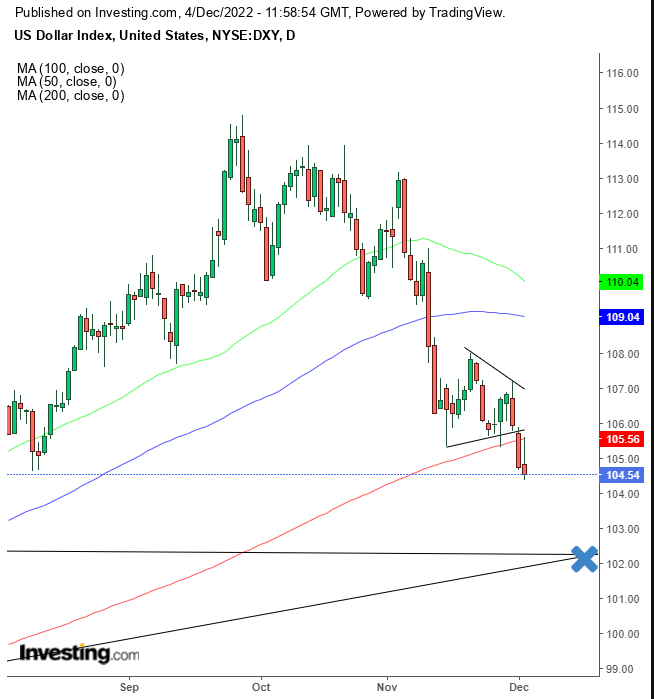- The short-term rebound of the S&P 500 faces a medium-term downtrend;
- New non-agricultural jobs exceeded expectations, and inflation continued to heat up;
- Will the Fed turn hawkish again?
Investing.com – The market narrative on Wall Street had investors rebalancing their positions last week as the Federal Reserve is reining in inflation with the most aggressive tightening since the 1980s and a full-blown U.S. recession is increasingly likely – U.S. president Short-term Treasury yields have fallen into the steepest inversion since 1981, and this has been seen as a leading indicator of economic recession.
At present, market participants generally believe that the strong economic growth in November is in stark contrast to the downward trend of the economy. However, my point of view is just the opposite. At present, if society creates more and more new jobs, it means that the degree of overheating of the economy has become deeper and deeper, and this will support the Fed to raise interest rates, which will increase the recession. probability.
Wall Street investors are now trying to figure out the extent to which U.S. stocks can absorb the impact of the economic recession. You must know that since 1950, during the recession, the average sell-off rate of U.S. stocks was as high as 29%.
Since the beginning of this year, it has fallen by more than a quarter from its high point, reaching the average decline in historical bear markets. However, according to data from the financial institution Hartford Funds, in the 26 bear markets since 1929, the average decline of the stock index was actually about 35.6%, and the time span was 289 days (about 9 and a half months).
Regardless of the fundamentals, I’ve been predicting continued bearishness in the market since the market’s technical peak.
(Weekly chart of S&P 500 from Investing.com)
Strictly speaking, the current medium-term trend in the United States should be a sideways trend. But in the short term, the recent rally has broken down to complete a rising wedge and the index will retest the October lows. If it falls lower, as I predict, it could form a head and shoulders continuation pattern, implying a downside move of almost 700 pips from the breakout point – difficult given the downward sloping nature of the neckline OK – Corresponds to the S&P 500 top above.
When looking at the S&P 500, I see that the technology and communication services sectors have been recovering on monthly and three-month time frames. So, could their short-term rally be the start of a reversal? I do not think so.
These growth stocks rose because the market has been in a risk-on mood in the short term. However, if the medium-term downtrend resumes, they will fall again. From a six-month and year-to-date perspective, the technology sector has underperformed, while sectors that have performed better in recessions, such as consumer staples, utilities and health care, are leading the way.
Just look, the dollar fell on Friday after Chicago Fed President Charles Evans said the Fed may slow the pace of rate hikes.
Evans, on the other hand, warned that the Fed may need to raise interest rates “slightly higher” than it expected in September. The dollar lost 6 percent in November, its worst month since September 2010, as traders shifted their positions in anticipation of a slowdown in rate hikes.

It is important to note that the USD has completed a bearish move, implying that the greenback will test the psychological round-number level of 100. However, watch out for the dual support of a trendline connecting highs from 2017 and an ascending trendline connecting lows from June 2021.
In gold, last Wednesday, rose 1%, Federal Reserve Chairman Jerome Powell said the Fed may slow down the pace of interest rate hikes after the December meeting. At the same time, he warned that it was not over yet, for which the bank’s preferred indicator for judgment is the index. Still, Friday’s strong jobs data pushed gold prices higher from a four-month high, but there could also be technical drivers.

On the daily chart, the 200-day moving average square formed a top reversal pattern – the hanging man – just at the August high, confirming that gold fell below the rising trend line for the first time since March 2021 possibility of reversal.
As mentioned earlier, the Fed’s interest rate hikes may slow down, but will not stop, as the surge in non-farm payrolls shows continued strength in the economy, which is not conducive to the downward revision of inflation. Therefore, the market will inevitably continue to fluctuate.
【This article is from Yingwei Caiqing Investing.com, to read more, please log in to cn.Investing.com or download Yingwei Caiqing App】
(Translation: Li Shanwen)
